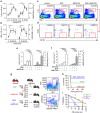Therapeutic targeting and rapid mobilization of endosteal HSC using a small molecule integrin antagonist
- PMID: 26975966
- PMCID: PMC4796355
- DOI: 10.1038/ncomms11007
Therapeutic targeting and rapid mobilization of endosteal HSC using a small molecule integrin antagonist
Abstract
The inherent disadvantages of using granulocyte colony-stimulating factor (G-CSF) for hematopoietic stem cell (HSC) mobilization have driven efforts to identify alternate strategies based on single doses of small molecules. Here, we show targeting α9β1/α4β1 integrins with a single dose of a small molecule antagonist (BOP (N-(benzenesulfonyl)-L-prolyl-L-O-(1-pyrrolidinylcarbonyl)tyrosine)) rapidly mobilizes long-term multi-lineage reconstituting HSC. Synergistic engraftment augmentation is observed when BOP is co-administered with AMD3100. Impressively, HSC in equal volumes of peripheral blood (PB) mobilized with this combination effectively out-competes PB mobilized with G-CSF. The enhanced mobilization observed using BOP and AMD3100 is recapitulated in a humanized NODSCIDIL2Rγ(-/-) model, demonstrated by a significant increase in PB CD34(+) cells. Using a related fluorescent analogue of BOP (R-BC154), we show that this class of antagonists preferentially bind human and mouse HSC and progenitors via endogenously primed/activated α9β1/α4β1 within the endosteal niche. These results support using dual α9β1/α4β1 inhibitors as effective, rapid and transient mobilization agents with promising clinical applications.
Figures





References
-
- Petit I. et al. G-CSF induces stem cell mobilization by decreasing bone marrow SDF-1 and up-regulating CXCR4. Nat. Immunol. 3, 687–694 (2002) . - PubMed
-
- Winkler I. G. et al. Hematopoietic stem cell mobilizing agents G-CSF, cyclophosphamide or AMD3100 have distinct mechanisms of action on bone marrow HSC niches and bone formation. Leukemia 26, 1594–1601 (2012) . - PubMed
-
- Cashen A. F., Lazarus H. M. & Devine S. M. Mobilizing stem cells from normal donors: is it possible to improve upon G-CSF? Bone Marrow Transplant. 39, 577–588 (2007) . - PubMed
-
- Gertz M. A. Current status of stem cell mobilization. Br. J. Haematol. 150, 647–662 (2010) . - PubMed
Publication types
MeSH terms
Substances
LinkOut - more resources
Full Text Sources
Other Literature Sources
Medical
Molecular Biology Databases

